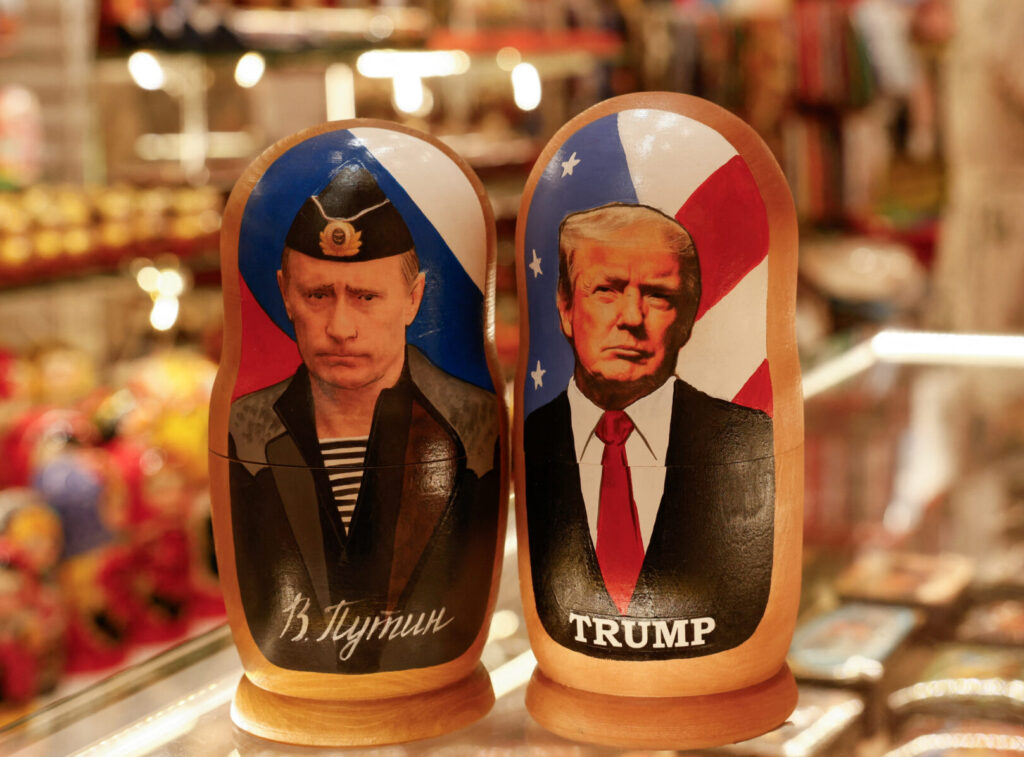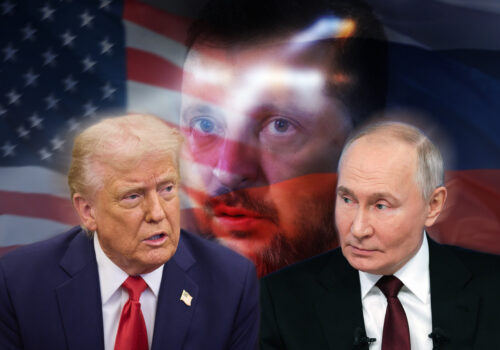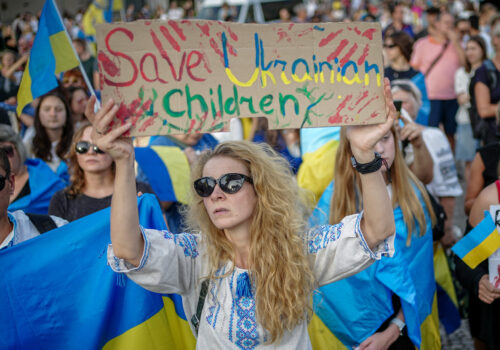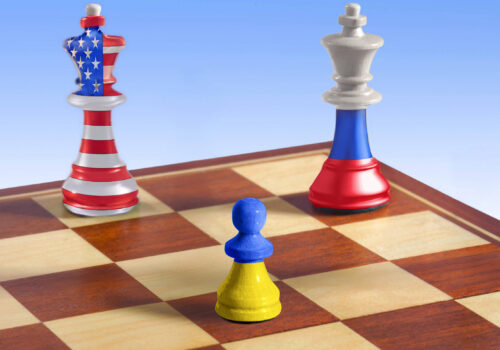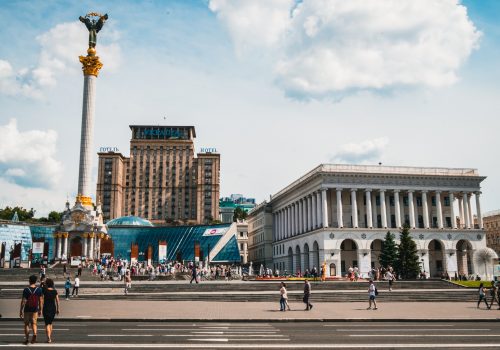As he prepared for this week’s meeting with Vladimir Putin in Alaska, US President Donald Trump appears to have sought inspiration from his earlier role as a New York real estate mogul. Ukraine and Russia will need to engage in “land swaps,” he said when news of the summit first broke. Since then, he has described Russian-occupied regions of Ukraine as “prime territory” while vowing to try and get some it back. “In real estate, we call it oceanfront property. That’s always the most valuable property,” he commented on August 11.
Trump’s real estate metaphors are part and parcel of his public persona and should not be taken at face value, of course. Nevertheless, his apparent belief that territorial concessions can bring peace suggests a fundamental misreading of Russia’s war aims. Trump may like to portray the invasion of Ukraine as a particularly acrimonious boundary dispute, but Putin most certainly does not share this view.
The Kremlin dictator isn’t fighting for mere land in Ukraine. He is fighting to extinguish Ukrainian independence altogether. Putin regards this as a decisive step toward reversing the verdict of 1991, reviving the Russian Empire, and establishing a new world order. Anyone who wishes to end the war in Ukraine must first reckon with the sheer scale of these imperial ambitions.
Stay updated
As the world watches the Russian invasion of Ukraine unfold, UkraineAlert delivers the best Atlantic Council expert insight and analysis on Ukraine twice a week directly to your inbox.
Trump is far from alone in failing to grasp why Putin went to war. Even now, more than three and a half years since the outbreak of hostilities, many in the West still struggle to appreciate the dominant role played by historical grievances and unadulterated imperialism. In order to understand Moscow’s true motivations, it is vital to detach oneself from the Western perspective and view the invasion through the prism of modern Russian history.
For Putin and millions of his fellow Russians, today’s war is inextricably linked to the humiliations of the Soviet collapse. This fact is often lost on Western audiences, who are inclined to assume that most Russians welcomed the demise of the totalitarian USSR. In reality, the breakup of the Soviet Union was a immensely traumatic experience for the vast majority of the Russian population, who saw their country reduced almost overnight from global superpower to banana republic. Between the late 1980s and the early 1990s, the Russian Empire in its Soviet form lost around one-third of its territory and almost two-thirds of its population, with the remainder plunged into desperate poverty. Rarely in history has an empire imploded so suddenly or completely.
As a KGB officer in East Germany, Putin had a front row seat for the early stages of this collapse. He was in Dresden when the Berlin Wall came down in 1989, and would bitterly recall the imperial paralysis he encountered as Soviet power began to unravel. “Moscow is silent,” the young Putin was told as he sought instruction during those tumultuous days. This disaster has haunted the Russian ruler ever since, shaping his worldview and making him determined to ensure that Moscow would never be silent again.
The trauma of the Soviet collapse helps to explain Putin’s Ukraine obsession. Like many of his compatriots, Putin has always regarded Ukraine as part of Russia’s historical heartlands and has never truly accepted Ukrainian independence. This did not present any real problems during the early years of the post-Soviet era, as the newly independent Ukraine remained firmly locked within the Kremlin orbit. However, once Ukraine’s own nation-building journey began to gain momentum in the 2000s, the country’s efforts to embrace a democratic European identity placed it on a direct collision course with Putin’s own rapidly evolving imperial agenda.
The watershed moment came in 2004, when a Russian-backed plot to rig Ukraine’s presidential election and install a Kremlin-friendly candidate backfired and provoked massive street protests that came to be known as the Orange Revolution. With millions of Ukrainians rallying in defense of democracy, the authorities backed down and ordered a rerun of the vote, which was duly won by the pro-Western opposition candidate.
Among international audiences, Ukraine’s democratic breakthrough was viewed as a continuation of the freedom wave that had swept through Eastern Europe following the fall of the Berlin Wall and transformed the region. Russia’s leaders were also painfully aware of the parallels between Ukraine’s revolution and the people power uprisings that had sparked the breakup of the Soviet Union.
The Orange Revolution had a particularly profound impact on Putin himself. He took the revolution personally, having inadvertently helped provoke the protests by traveling to Kyiv on the eve of the election to lecture the Ukrainian public on how to vote. Putin now became increasingly paranoid about the prospect of a similar people power uprising in Moscow and began accusing the West of attempting to foment “color revolutions” against him. Three months after the Orange Revolution, he made his new political position clear by delivering a landmark speech describing the fall of the USSR as a “geopolitical catastrophe.”
From this point on, Putin’s hostility to Ukraine would only grow. He saw the country’s democratic transformation as a direct threat to his own authoritarian regime. If left unchecked, Ukraine’s fledgling democracy could prove contagious and serve as a catalyst for the breakup of the Russian Federation itself. Having already witnessed the power of grassroots democratic uprisings in the late 1980s, Putin had no intention of risking a repeat. Instead, he became fixated with the idea of subverting Ukrainian democracy and reasserting Russian control over the country.
Eurasia Center events

Throughout the decade following the Orange Revolution, Putin sought to undermine Ukrainian independence via massive campaigns of political and economic interference. When Ukrainians defied the Kremlin and took to the streets once more in the 2014 Revolution of Dignity, Putin responded by seizing Crimea and invading eastern Ukraine’s Donbas region. Much to his frustration, this limited military intervention failed to derail Ukraine’s Euro-Atlantic integration. On the contrary, it united Ukraine and dramatically strengthened Ukrainian national identity. Faced with the prospect of losing Ukraine altogether, Putin then took the fateful decision to launch the full-scale invasion of February 2022.
Since 2022, Putin has provided ample evidence of his intention to destroy Ukraine as a state and as a nation. In the 20 percent of Ukraine currently under Kremlin control, all traces of Ukrainian identity are being ruthlessly erased amid a reign of terror involving mass arrests and deportations. A United Nations probe has concluded that Russia is guilty of committing crimes against humanity throughout the occupied regions of Ukraine.
The Kremlin’s eliminationist agenda in occupied Ukraine mirrors the rabidly anti-Ukrainian rhetoric that dominates contemporary Russian political discourse and shapes the country’s information space. Putin himself routinely insists that Ukrainians are actually Russians (“one people”), while many of his Kremlin colleagues openly question Ukraine’s right to exist.
Moscow’s uncompromising position during recent peace negotiations in Istanbul has further underlined Putin’s maximalist war aims and confirmed his refusal to coexist with a separate and sovereign Ukrainian state. Russia insists that postwar Ukraine must agree to be partitioned, demilitarized, and internationally isolated before a ceasefire can be implemented. It does not take much imagination to predict what Putin intends to do once rump Ukraine has been rendered defenseless in this manner.
Having positioned Ukraine as an intolerable “anti-Russia,” it is difficult to see how Putin can now settle for anything less than the end of Ukrainian statehood. Any negotiated settlement that safeguarded the survival of an independent Ukraine would be regarded in Moscow as a major defeat. This makes a complete mockery of US-led efforts to broker a compromise peace. After all, there can be no meaningful compromise between Russia’s genocidal objectives and Ukraine’s national survival.
On the eve of the Alaska summit, both Washington and Moscow appeared to be actively downplaying expectations. This is probably wise. The first bilateral meeting between the US and Russian leaders during the full-scale invasion Ukraine is clearly a significant event, but at this early stage in the negotiating process, Putin’s undiminished imperial aspirations leave little room for Trump’s fabled dealmaking skills.
Ultimately, if Trump wants to end the bloodshed in Ukraine, he must speak to Putin in the language of strength. The US leader undoubtedly has the tools to do so, but he has so far sought to avoid a direct confrontation with the Russian dictator. Unless that changes, the war will continue. Putin currently has no intention of abandoning an invasion that he views in sacred terms as an historic mission, and will not be persuaded by the promise of minor territorial concessions, even if what’s on offer happens to be “prime real estate.”
Peter Dickinson is editor of the Atlantic Council’s UkraineAlert service.
Further reading
The views expressed in UkraineAlert are solely those of the authors and do not necessarily reflect the views of the Atlantic Council, its staff, or its supporters.

The Eurasia Center’s mission is to enhance transatlantic cooperation in promoting stability, democratic values, and prosperity in Eurasia, from Eastern Europe and Turkey in the West to the Caucasus, Russia, and Central Asia in the East.
Follow us on social media
and support our work
Image: Russian traditional nesting dolls, known as Matryoshkas, with images of Russian President Vladimir Putin and U.S. President Donald Trump are placed on a shelf during a demonstration at a gift shop in central Moscow, Russia, August 12, 2025. (REUTERS/Yulia Morozova)
